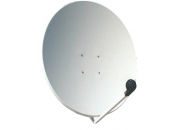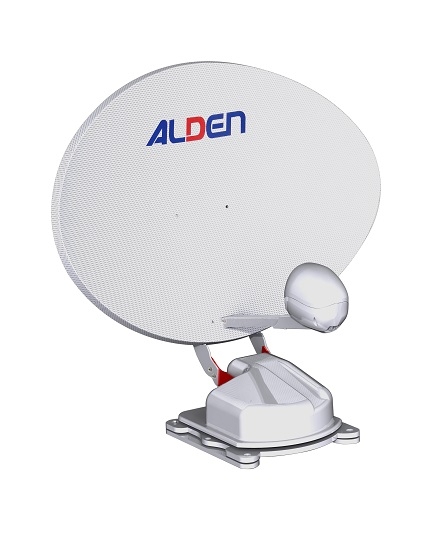Satellite Products
What channels can I get on satellite?
This is a very broad question, as reception varies depending on the equipment you have. There are two main (frequency) bands in which satellite TV is transmitted: C band which is in the 3.4 to 4.2 GHz frequency band. KU band which covers 11 to 12.75 GHz At these frequencies, the signals are microwave. Differences between the bands Generally C-Band requires a larger dish and KU band a smaller dish. A C-Band dish is usually 2M or larger in diameter, and KU band dishes vary from 65cm to 2M.C band dishes are usually mesh as the surface accuracy does not to be as accurate as it needs to be for KU band.
Therefore KU band dishes are usually solid with a smooth surface as they need to be accurately made to focus the small KU band waves into the feed horn on the LNB. The LNBs (Low noise block down-converter) sits in the front or centre of the dish, and collects all the reflected micro-waves from the dish. The micro-waves are very very weak, and are not harmful. The LNBF has an integrated feed horn, and the waves travel along the feed horn, and enter the LNB where they are converted and transferred to the satellite receiver via the coax cable.
C Band Systems
C-Band contains many free channels, most of which are foreign language. There are 9 or 10 satellites accessible from the East and West Coast of Australia. Your C band dish can be a fixed type system, with 2M mesh dish, C band LNBF, coax cable and digital satellite receiver, or it can be motorized to point to all of the C band satellites in your region. A fixed C band dish system is usually installed on the ground, and points to one of the 10 satellites in your region. Free to air channels from this one satellite can be viewed.
A Satellite channel list is available on our Satellites page, courtesy of Lyngsat. The average cost of a 2.3M fixed C band system is under $1200 installed. Motorizing your system can allow it to point to all (providing you have no obstructions such as trees etc) satellites in your region and you can move the dish remotely as you require. To motorize your dish you firstly need a special type of pivoting mount on the dish. This is called a polar mount and comes standard on most larger dishes.
Other additional items required are an actuator and positioner, and connecting cable. The actuator is the “ram” like unit which fits on your dish and does the moving, and the positioner is the inside unit that controls the actuator and “remembers” the satellite positions. The positioner usually comes with a remote control for the user. There are also a type of positioner that interface with most modern digital satellite receivers using a protocol called DisEQc 1.2. These are called V-BOX, and use the existing Digital receiver remote control to control the satellite dish position. The average cost of a 2.3M motorized C band system is under $1600 installed.
KU Band Systems
KU-Band contains some (maybe 60) free to air channels. Most of the Channels are on Optus B3. These free channels are mainly Foreign language channels, and Christian Channels on Optus B3. To receive these FTA channel, you would need an 80cm dish and KU band LNBF, and a Free to Air digital satellite receiver such as the Healing HHS242.
Other channels on KU band are PAY TV channels and VAST remote area channels and require a Digital satellite receiver with card slot, and an authorized smart card and subscription (for Pay TV) to view them. The Pay TV receiver and card are supplied by the PAY TV provider when you take up a subscription. Other digital satellite receivers such as the ClearView HD1009IR with embedded Irdeto card slot will work with some original smart card; however some of the PAY TV providers cards will not work in other receivers and will only work with the receiver they supply.
There are some exceptions, Mysat Arabic, Greek and Italian service and SUN TV Tamil service. These cards will work in out HD1009IR. Pay TV channels presently have 2 types of encryption in Australia, Irdeto and NDS. The receivers mentioned above should work only with the Irdeto system, and only with an original smart card with subscription. VAST is platform on Optus C1/D3 satellites that has a group of channels that contain free to air Television similar to the channels on the terrestrial service.
SBS and ABC are available to anyone within Australia. The Commercial channels are available only* to anyone in Australia that outside the footprint of terrestrial transmitters. Channels need to be ctivated before they can be watched. They can be activated by phoning or faxing each Broadcaster. All channels are free to activate except for Imparja who will charge $55 per activation.
A certified VAST receiver and matched smart card are required and these can be purchased from us as we are an VAST dealer. We have 2 models the SatKing DVBS800CA and the Humax HDR1003S. Dish sizes required are a minimum of 60cm Australia wide, and Northern areas such as the NT and Cape York need larger sizes up to 90cm. Smaller dishes as small as 45cm may work, however the signal on these dishes will drop out quickly in overcast or rainy conditions. Once the equipment is obtained and installed, VAST need to be contacted to have the card “turned on”. Once turned on, there are no further on-going fees. The Aurora service is only for use within Australia. Other Countries such as Papua New Guinea and New Zealand may receive the signal, but are not entitled to view the programming.
If you are a traveller in a caravan or motorhome you are entitled to have your VAST receiver activated while travelling. The activation period is 6 months. After the 6 months if you are still travelling you can re-apply for a further 6 months by calling VAST on 1300993376 You can activate VAST smartcards for homes or travellers by going to the http://www.mysattv.com.au web site. You can re-activate previously activated cards here http://www.myvast.com.au/register/reactivate
*There is a provision for viewers with poor TV reception within the terrestrial viewing area, to receive the VAST commercial channel via satellite. An application needs to be made to VAST and is usually approved within 6 weeks. ABC and SBS can be activated immediately; however the commercial channels need approval before being activated. For more info on whether you are eligible to be activated for your area go to http://www.mysattv.com.au
Can C and KU band be integrated into the one system?
Yes, however this requires a dual band feed horn, a C band LNBF and a KU band LNBF in one, . The performance is compromised when a dual band feed horn is used, and using a mesh dish for KU band is about 20% less efficient than using a solid dish. The preferred method to receiver C and KU band is to have 2 separate dishes. Say a 2.3M mesh motorized dish for C band, and a fixed 90cm to 1.2M solid dish for KU band, with some diseqc electronic switching to select between the 2 dishes.
So you can receive about 140 free to air channels with a motorized C band dish, 130 of which are foreign language, German, French, Italian, Portuguese, Hindi, Tamil, Cantonese, Mandarin, Thai, Vietnamese, Indonesian, Japanese, and about 10 English. On the KU band system you can receive some free channels, and if you have a PAY TV card, you can receive the channels you pay for. If you have a VAST system, you can receive channels similar to the digital terrestrial channels in Australia.




